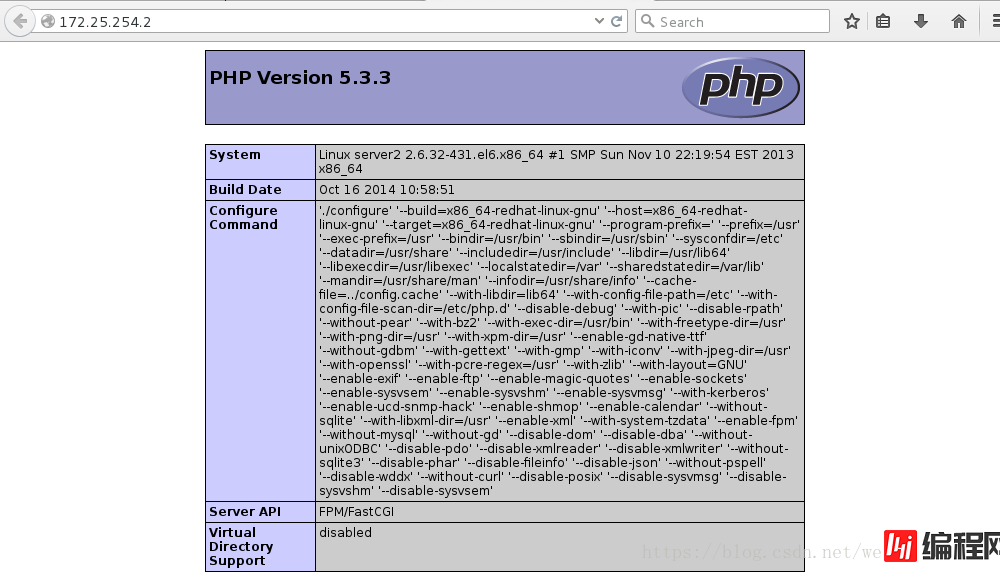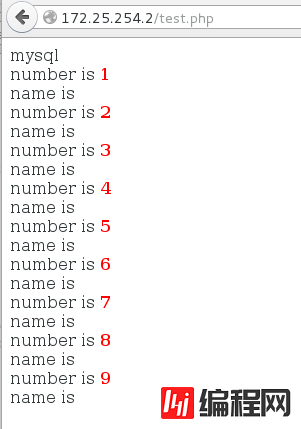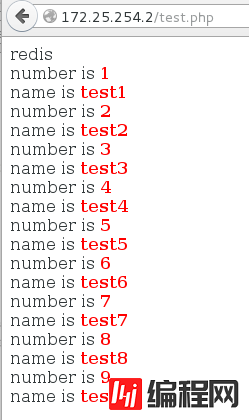这篇文章主要为大家展示了“Redis服务器环境下Mysql如何实现lnmp架构缓存”,内容简而易懂,条理清晰,希望能够帮助大家解决疑惑,下面让小编带领大家一起研究并学习一下“redis服务器环境下mysql
这篇文章主要为大家展示了“Redis服务器环境下Mysql如何实现lnmp架构缓存”,内容简而易懂,条理清晰,希望能够帮助大家解决疑惑,下面让小编带领大家一起研究并学习一下“redis服务器环境下mysql如何实现lnmp架构缓存”这篇文章吧。
配置环境:redhat6.5
server1:redis(172.25.254.1)
server2:PHP(172.25.254.2)
server3:mysql(172.25.254.3)
配置步骤:
server2:
1、server2安装php的redis相应模块

2、nginx安装
[root@server2 php-fpm.d]# rpm -ivh Nginx-1.8.0-1.el6.ngx.x86_64.rpm
warning: nginx-1.8.0-1.el6.ngx.x86_64.rpm: Header V4 RSA/SHA1 Signature, key ID 7bd9bf62: NOKEY
Preparing... ########################################### [100%]
1:nginx ########################################### [100%]
----------------------------------------------------------------------
Thanks for using nginx!
Please find the official documentation for nginx here:
* https://nginx.org/en/docs/
Commercial subscriptions for nginx are available on:
* Https://nginx.com/products/
----------------------------------------------------------------------
[root@server2 php-fpm.d]# id nginx
uid=498(nginx) gid=499(nginx) groups=499(nginx)3、nginx和php配置
1、php配置
[root@server2 php-fpm.d]# cd /etc/php-fpm.d/
[root@server2 php-fpm.d]# id nginx
uid=498(nginx) gid=499(nginx) groups=499(nginx)
[root@server2 php-fpm.d]# vim www.conf
39 user = nginx
41 group = nginx
[root@server2 php-fpm.d]# vim /etc/php.ini
946 date.timezone = Asia/Shanghai
[root@server2 php-fpm.d]# /etc/init.d/php-fpm start
Starting php-fpm: [ OK ]
[root@server2 php-fpm.d]# netstat -antlp | grep php
tcp 0 0 127.0.0.1:9000 0.0.0.0:* LISTEN 1125/php-fpm
[root@server2 php-fpm.d]# vim /etc/php.ini2、nginx配置
[root@server2 ~]# cd /etc/nginx/conf.d/
[root@server2 conf.d]# ls
default.conf example_ssl.conf
[root@server2 conf.d]# vim default.conf
10 index index.php index.html index.htm;
30 location ~ \.php$ {
31 root html;
32 fastcgi_pass 127.0.0.1:9000;
33 fastcgi_index index.php;
34 fastcgi_param SCRIPT_FILENAME /usr/share/nginx/html$fastcgi_script _name;
35 include fastcgi_params;
36 }
[root@server2 conf.d]# nginx -t
nginx: the configuration file /etc/nginx/nginx.conf syntax is ok
nginx: configuration file /etc/nginx/nginx.conf test is successful
[root@server2 conf.d]# nginx
[root@server2 conf.d]# netstat -anplt |grep nginx
tcp 0 0 0.0.0.0:80 0.0.0.0:* LISTEN 1141/nginx
php测试:
[root@server2 conf.d]# cd /usr/share/nginx/html/
[root@server2 html]# vim index.php
[root@server2 html]# cat index.php
<!--php
phpinfo()
-->
[root@server2 html]# /etc/init.d/php-fpm reload
Reloading php-fpm: [14-Jul-2018 01:09:13] NOTICE: configuration file /etc/php-fpm.conf test is successful
[ OK ]物理机访问:

4、php配置redis+mysql
[root@server2 ~]# cd /usr/share/nginx/html/
[root@server2 html]# vim test.php
<!--php
$redis = new Redis();
$redis--->connect('172.25.254.1',6379) or die ("could net connect redi s server");
# $query = "select * from test limit 9";
$query = "select * from test";
for ($key = 1; $key < 10; $key++)
{
if (!$redis->get($key))
{
$connect = mysql_connect('172.25.254.3','redis','wes tos');
mysql_select_db(test);
$result = mysql_query($query);
//如果没有找到$key,就将该查询sql的结果缓存到redis
while ($row = mysql_fetch_assoc($result))
{
$redis->set($row['id'],$row['name']);
}
$myserver = 'mysql';
break;
}
else
{
$myserver = "redis";
$data[$key] = $redis->get($key);
}
}
echo $myserver;
echo "
";
for ($key = 1; $key < 10; $key++)
{
echo "number is $key";
echo "
";
echo "name is $data[$key]" ;
echo "
";
}
>5、添加php支持的redis模块
[root@server2 ~]# unzip phpredis-master.zip
[root@server2 ~]# cd phpredis-master
[root@server2 phpredis-master]# phpize
Configuring for:
PHP api Version: 20090626
Zend Module Api No: 20090626
Zend Extension Api No: 220090626
[root@server2 phpredis-master]# ls
acinclude.m4 config.sub library.c README.markdown
aclocal.m4 configure library.h redis.c
autom4te.cache configure.in ltmain.sh redis_session.c
build CREDITS Makefile.global redis_session.h
common.h debian missing run-tests.php
config.guess debian.control mkdeb-apache2.sh serialize.list
config.h.in igbinary mkinstalldirs tests
config.m4 install-sh php_redis.h
[root@server2 phpredis-master]# ./configure
[root@server2 phpredis-master]# make && make install
[root@server2 ~]# cd /etc/php.d/
[root@server2 php.d]# ls
curl.ini JSON.ini mysql.ini pdo_sqlite.ini zip.ini
fileinfo.ini mbstring.ini pdo.ini phar.ini
gd.ini mysqli.ini pdo_mysql.ini sqlite3.ini
[root@server2 php.d]# cp mysql.ini redis.ini
[root@server2 php.d]# vim redis.ini
2 extension=redis.so
[root@server2 php.d]# /etc/init.d/php-fpm reload
Reloading php-fpm: [14-Jul-2018 01:21:56] NOTICE: configuration file /etc/php-fpm.conf test is successful
[ OK ]
[root@server2 php.d]# php -m |grep redis
redis
server3:mysql配置1、安装mysql-server
[root@server3 ~]# rpm -qa | grep mysql
mysql-commUnity-common-5.7.17-1.el6.x86_64
mysql-community-client-5.7.17-1.el6.x86_64
mysql-community-libs-compat-5.7.17-1.el6.x86_64
mha4mysql-node-0.56-0.el6.noarch
mysql-community-libs-5.7.17-1.el6.x86_64
mysql-community-server-5.7.17-1.el6.x86_64
[root@server3 ~]# rpm -e `rpm -qa|grep mysql` --nodeps ##不考虑依赖性删除mysql
warning: /etc/my.cnf saved as /etc/my.cnf.rpmsave
[root@server3 ~]# rpm -qa | grep mysql
[root@server3 ~]# cd /var/lib/mysql/
[root@server3 mysql]# rm -fr *
[root@server3 mysql]# ls
[root@server3 mysql]# yum install -y mysql-server ##安装2、开启mysql,并导入测试数据库
[root@server3 ~]# /etc/init.d/mysqld start
[root@server3 ~]# mysql < test.sql
[root@server3 ~]# mysql < test.sql
[root@server3 ~]# cat test.sql
use test;
CREATE TABLE `test` (`id` int(7) NOT NULL AUTO_INCREMENT, `name` char(8) DEFAULT NULL, PRIMARY KEY (`id`)) ENGINE=InnoDB DEFAULT CHARSET=utf8;
INSERT INTO `test` VALUES (1,'test1'),(2,'test2'),(3,'test3'),(4,'test4'),(5,'test5'),(6,'test6'),(7,'test7'),(8,'test8'),(9,'test9');
#DELIMITER $$
#CREATE TRIGGER datatoredis AFTER UPDATE ON test FOR EACH ROW BEGIN
# SET @RECV=gman_do_background('syncToRedis', json_object(NEW.id as `id`, NEW.name as `name`));
# END$$
#DELIMITER ;3、数据库授权
[root@server3 ~]# mysql
mysql> grant all on test.* to redis@'%' identified by 'westos';
Query OK, 0 rows affected (0.00 sec)
mysql> select * from test.test;
+----+-------+
| id | name |
+----+-------+
| 1 | test1 |
| 2 | test2 |
| 3 | test3 |
| 4 | test4 |
| 5 | test5 |
| 6 | test6 |
| 7 | test7 |
| 8 | test8 |
| 9 | test9 |
+----+-------+
9 rows in set (0.00 sec)测试:访问172.25.254.2/test.php
1、php默认从redis 索取数据,第一次redis无缓存,则php从mysql'索取数据
第一次无缓存

第二次索取数据后:

redis节点也可查看
[root@server1 redis-4.0.1]# redis-cli
127.0.0.1:6379> get 2
"test2"2、将数据库server3节点内容更新并删除节点,则php从数据库索取数据节点更新内容
mysql> update test.test set name='westos' where id=1;
Query OK, 1 row affected (0.05 sec)
Rows matched: 1 Changed: 1 Warnings: 0
mysql> select * from test.test;
+----+--------+
| id | name |
+----+--------+
| 1 | westos |
| 2 | test2 |
| 3 | test3 |
| 4 | test4 |
| 5 | test5 |
| 6 | test6 |
| 7 | test7 |
| 8 | test8 |
| 9 | test9 |
+----+--------+
9 rows in set (0.00 sec)redis的master主机删除节点内容
[root@server1 redis-4.0.1]# redis-cli
127.0.0.1:6379> get 2
"test2"
127.0.0.1:6379> del 1
(integer) 1
127.0.0.1:6379> get 1
(nil)刷新页面,再次访问

以上是“redis服务器环境下mysql如何实现lnmp架构缓存”这篇文章的所有内容,感谢各位的阅读!相信大家都有了一定的了解,希望分享的内容对大家有所帮助,如果还想学习更多知识,欢迎关注编程网数据库频道!
--结束END--
本文标题: redis服务器环境下mysql如何实现lnmp架构缓存
本文链接: https://lsjlt.com/news/56136.html(转载时请注明来源链接)
有问题或投稿请发送至: 邮箱/279061341@qq.com QQ/279061341
2024-10-23
2024-10-22
2024-10-22
2024-10-22
2024-10-22
2024-10-22
2024-10-22
2024-10-22
2024-10-22
2024-10-22
回答
回答
回答
回答
回答
回答
回答
回答
回答
回答
0